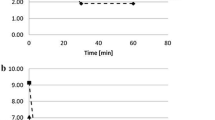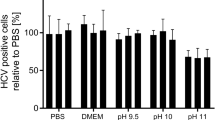Abstract
Viral safety is a prerequisite for manufacturing clinical albumin and immunoglobulins from human plasma pools. This study was designed to evaluate the efficacy of cold ethanol fractionation and pasteurization (60°C heat treatment for 10 h) for the removal inactivation of human immunodeficiency virus type 1 (HIV-1) during the manufacturing of albumin and immunoglobulins. Samples from the relevant stages of the production process were spiked with HIV-1, and the amount of virus in each fraction was quantified by the 50% tissue culture infectious dose (TCID50). Both fraction IV fractionation and pasteurization steps during albumin processing were robust and effective in inactivating HIV-1, titers of which were reduced from an initial 8.5 log10 TCID50 to undetectable levels. The log reduction factors achieved were ≥4.5 and ≥6.5, respectively. In addition, fraction III fractionation and pasteurization during immunoglobulins processing were robust and effective in eliminating HIV-1. HIV-1 titers were reduced from an initial 7.3 log10 TCID50 to undetectable levels. The log reduction factors achieved in this case were ≥4.9 and ≥5.3, respectively. These results indicate that the process investigated for the production of albumin and immunoglobulins have sufficient HIV-1 reducing capacity to achieve a high margin of safety.
Similar content being viewed by others
References
Cohn, E. J., L. E. Strong, W. L. Hughes Jr, D. J. Mulford, J. N. Ashworth, M. Melin, and H. L. Taylor (1946) Preparation and properties of serum and plasma proteins. IV. A system for the separation into fractions of the proteins and lipoprotein components of biological tissues and fluids.J. Am. Chem. Soc. 68: 459–475.
Horowitz, B. (1990) Blood protein derivative viral safety: observations and analysis.Yale J. Med. 63: 361–369.
Mosley, J. W. and J. Rakela (1999) Foundling viruses and transfusion medicine.Transfusion 39: 1041–1044.
Berkman S. A. (1988) Infectious complications of blood transfusion.Blood Rev. 2: 206–210.
Schilt, U. (1989) Overview of viruses relevant to blood transfusion.Curr. Stud. Hematol. Blood Transfus. 56: 1–8.
Cuthbertson, B., K. G. Reid, and P. R. Foster (1991) Viral contamination of human plasma and procedures for preventing virus transmission by plasma products. pp. 385–435. In: J. R. Harris (eds.).Blood separation and plasma fractionation. Wiley-Liss., NY, USA.
Will, R. G., J. W. Ironside, M. Zeidler, S. N. Cousens, K. Estibeiro, A. Alperovitch, S. Poster, M. Pocchiari, A. Hofman, and P. G. Smith (1996) A new varient of Creutzfeldt-Jakob-Disease in the UK.Lancet 347: 921–925.
Erstad, B. L. (1996) Viral infectivity of albumin and plasma protein fraction.Pharmacotherapy 16: 996–1001.
Roberts, P. (1996) Virus safety of plasma products.Rev. Med. Virol. 6: 25–38.
Federal Health Office and Paul Ehrlich Institute Federal Office for Sera and Vaccines (1994) Notice on the registration of drugs: requirements for validation studies to demonstrate the virus safety of drugs derived from human blood or plasma.Bundesanzeiger 84: 4742–4744.
The European Agency for the Evaluation of Medicinal Products: Human Medicines Evaluation Unit. Committee for Proprietary Medicinal Products (CPMP). Note for guidance on virus validation studies: the design, contribution and interpretation of studies validating the inactivation and removal of viruses (CPMP/BWP/268/95).
The European Agency for the Evaluation of Medicinal Products: Human Medicines Evaluation Unit. Committee for Proprietary Medicinal Products (CPMP). Note for guidance on plasma derived medicinal products (CPMP/BWP/269/95 rev 2).
The European Agency for the Evaluation of Medicinal Products: Human Medicines Evaluation Unit. Committee for Proprietary Medicinal Products (CPMP). Note for guidance on quality of biotechnology products: viral safety evaluation of biotechnology products derived from cell Lines of human or animal origin (CPMP/ICH/295/95).
International Conference on Harmonisation (1998) Guidance on viral safety evaluation of biotechnology products derived from cell lines of human or animal origin; Availability.Federal Resister 63(185): 51074–51084.
Oncley, J. L., M. Melin, D. A. Richert, J. W. Cameron, and P. M. Jr. Gross (1949) The separation of the antibodies, isoaggulitinins, prothrombin, plasminogen and β1-lipoprotein into subfractions of human plasma.J. Am. Chem. Soc. 71: 541–550.
Kärber, J. (1931) Beitrag zur kollectiven Behandlung pharmakologische Reihenversuche.Arch. Exp. Path. Pharmak. 162: 480–483.
Morgenthaler, J. J. (1989) Inactivation of viruses and safety of stable plasma products.Beitr. Infusionsther. 24: 33–39.
Menache, D. and D. L. Aronson (1985) Measures to inactivate viral contaminants of pooled plasma products.Prog. Clin. Biol. Res. 182: 407–423.
Heimburger, N. and H. E. Karges (1989) Strategics to produce virus-safe blood derivatives.Curr. Stud. Hentatol. Blood Transfus. 56: 23–33.
Heldebrant, C. M., E. D. Gomperts, C. K. Kasper, J. S. McDougal, A. E. Friedman, D. S. Hwang, E. Muchmore, S. Jordan, R. Miller, E. Sergis-Da-Venport, and W. Lam (1985) Evaluation of two viral inactivation methods for the preparation of safer factor VIII and factor IX concentrates.Transfusion 25: 510–515.
Nowak, T., J.-P. Gregersen, U. Klockmann, L. B. Cummins, and J. Hilfenhaus (1992) Virus safety of human immunoglobulins: efficient inactivation of hepatitis C and other human pathogenic viruses by the manufacturing procedure.J. Med. Virol. 36: 209–216.
Uemura, Y., Y. H. J. Yang, C. M. Heldebrant, K. Takechi, and K. Yokoyama (1994) Inactivation and elemination of viruses during preparation of human intravenous immunoglobulin.Vox Sang. 67: 246–254.
Author information
Authors and Affiliations
Corresponding author
Rights and permissions
About this article
Cite this article
Kim, I.S., Eo, H.G., Park, C.W. et al. Removal and inactivation of human immunodeficiency virus (HIV-1) by cold ethanol fractionation and pasteurization during the manufacturing of albumin and immunoglobulins from human plasma. Biotechnol. Bioprocess Eng. 6, 25–30 (2001). https://doi.org/10.1007/BF02942246
Received:
Accepted:
Issue Date:
DOI: https://doi.org/10.1007/BF02942246




